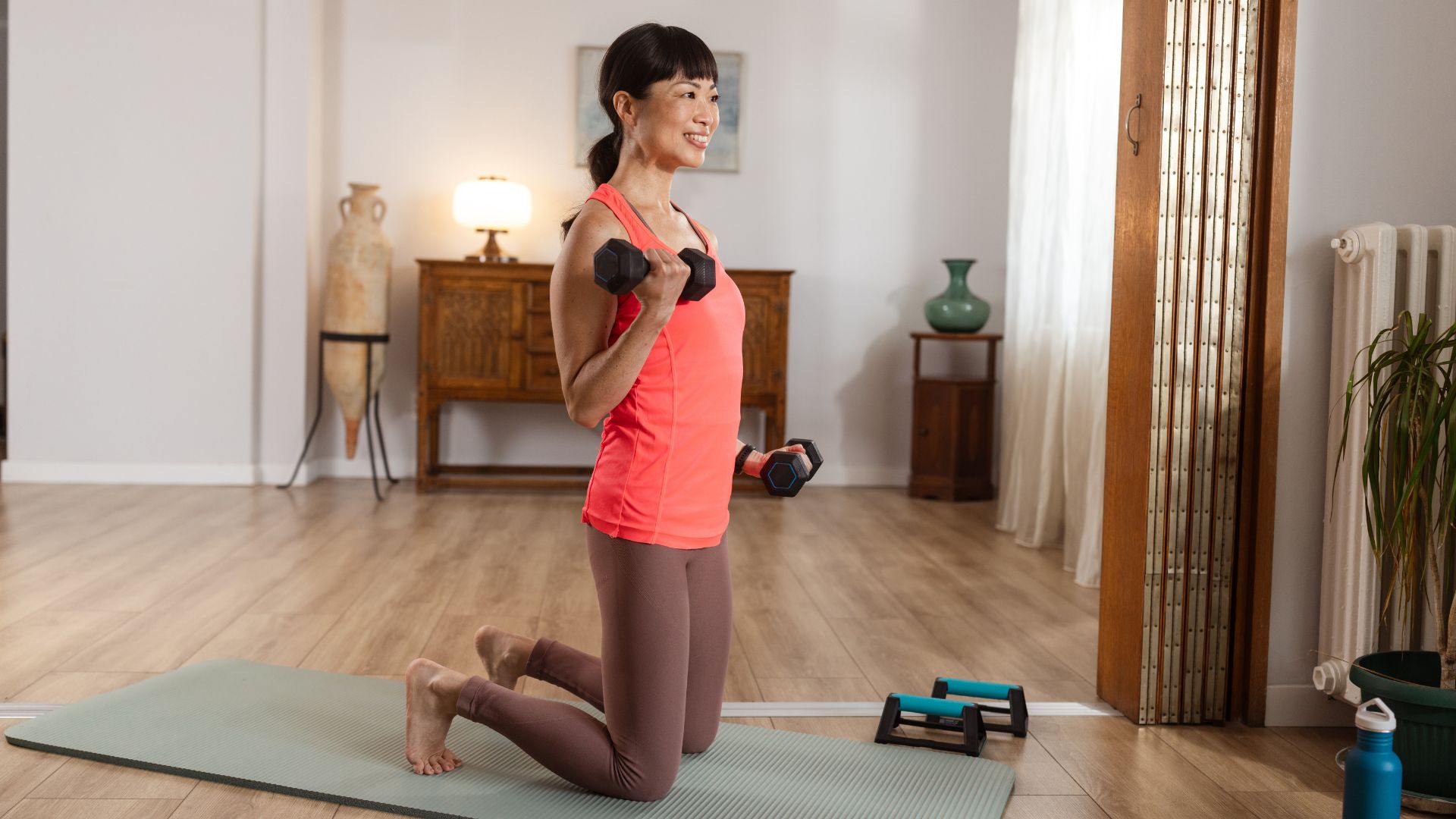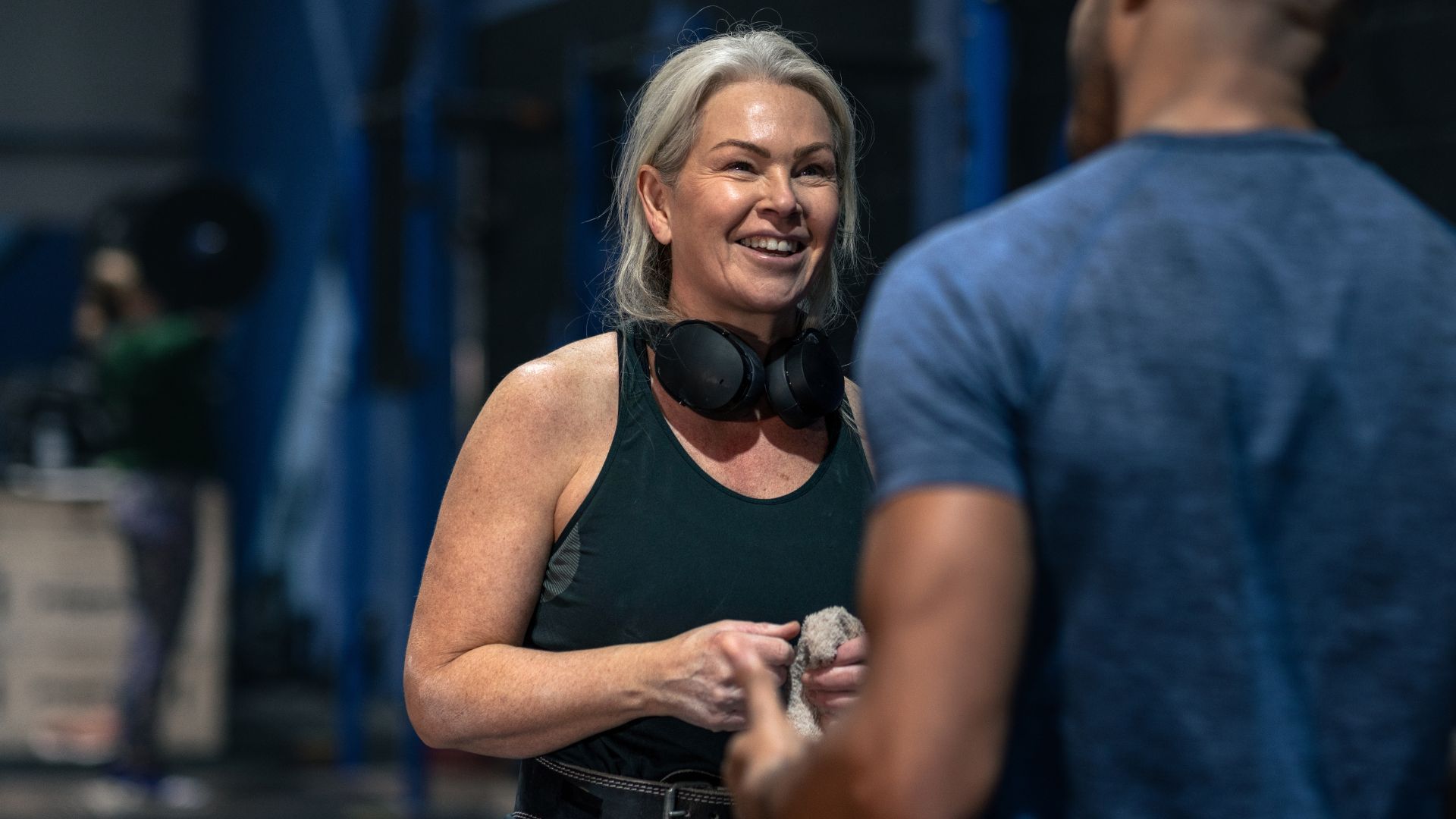Strength training for women - why it’s so important and 6 exercises to get started
Strength training for women can make all the difference for the mind and body, with or without weights. Here, Health Editor Grace Walsh talks through the basics


Strength training for women is one of the best workouts, no matter your age or fitness level. Grabbing some weights and following along with a class or your own routine, at the gym or at home, has numerous benefits for our health and mental wellbeing.
While strength training has so many benefits, it can be daunting if you aren't familiar with it - or don't know someone who regularly goes to the gym. But it doesn't have to be. Also called resistance training or sometimes weightlifting, strength training comes down to using weights like dumbbells, barbells, kettlebells, and resistance bands to push your muscles to fatigue. Alternatively, you can use your body weight as resistance and do strength training at home for beginners.
With benefits like improved strength, bone density, balance, and even confidence, there's every reason to try it yourself. As woman&home's digital health editor, a keen gym goer, and a certified fitness instructor, I recommend it as one of the best workouts for women. Along with certified personal trainers, I reveal what it's all about. with a quick routine to get started.
What is strength training for women?
Strength training is the simple concept of resistance against the muscles to make them stronger and to build muscle mass and endurance. It can be done with weights (like dumbbells, kettlebells, and barbells), with body weight, with resistance bands, or with machines at the gym.
It's important to start with lighter weights or use your body weight when starting at home or in a beginners' gym routine, but it's essential to make the exercises more difficult to reap the rewards. This is known as progressive overload.
"A good training program should be well-balanced and focused on strengthening all musculature," explains Aroosha Nekonam, a senior personal trainer at Ultimate Performance. "You should always be lifting at an effective intensity for growth, progressive overload and effective recovery, regardless of gender."
You can achieve progressive overload by increasing the heaviness of the weight, increasing the repetitions (how many times you do the movement), or slowing the movement down so you spend more time under tension. Doing this forces your muscles to adapt and encourages them to grow stronger over time, a process that works for both men and women.
Sign up to our free daily email for the latest royal and entertainment news, interesting opinion, expert advice on styling and beauty trends, and no-nonsense guides to the health and wellness questions you want answered.
Strength training benefits for women
1. Stronger muscles
Any time you have unfamiliar resistance against your muscles, tiny tears form in the fibres. During rest (and with the help of enough protein), these tears heal and the repaired fibres come back stronger than before, so strength improves and the size of the muscle increases.
Many women avoid strength training as they worry lifting weights will make them 'bulk-up'. Jemma Thomas, a personal trainer specialising in women's fitness, says this is a common myth. "Weight training can be slightly misunderstood in that sense," she says. "It's actually very difficult to bulk up as most women have much less testosterone than men, so it wouldn't really happen unless you trained for that specific purpose and looked at the nutrition side too."
The benefits of being strong are obvious - but building and maintaining muscle mass is particularly important for women approaching menopause. As the body doesn't have oestrogen's protective benefits anymore, many women are at risk of sarcopenia (a loss of muscle mass), which can have serious health consequences.
It's why strength training is one of the best exercises for longevity as well.
"Reduced muscle mass puts menopausal women at increased risk of falls and bone fractures, as well as the health risks associated with poorer body composition, such as high blood pressure, type 2 diabetes, and so on," says Emily Servante, a personal trainer who also works with Ultimate Performance.
Supplementing your diet and strength training routine with supplements like creatine for women and one of the best protein powders can also help.
2. Build bone density
Just as weight training can help maintain muscle mass, it can help maintain bone density, which is very important as menopausal women are at a higher risk of developing conditions like osteoporosis. Resistance training can help prevent this by "stressing your bones", says Aimee Victoria Long, a women's personal trainer and the founder of the Body Beautiful Method.
During a workout, whether it's a weighted Pilates class or traditional weightlifting, the muscles pull against the bones in the body, which kickstarts the creation of bone-forming cells.
3. Improve cardiovascular health
Much like weight loss, we often think of cardio exercise as the most practical way to boost cardiovascular fitness. While walking, running, cycling, and so on certainly have benefits, those same benefits can be found with weight training.
A review published in the Journal of Medicine and Science in Sports and Exercise found, for instance, that less than an hour per week of resistance training can reduce the risk of cardiovascular disease and all causes of early mortality.

Strength training is an easy workout to do at home as well with some weights and a yoga mat.
4. 'Tone' up
When people talk about 'toning', they are actually referring to building muscle. The more muscle you have, the more appears and the less visible fat mass you have, giving that 'toned' appearance.
While low-intensity cardio like walking or running 30 minutes a day is seen as the 'to-go' exercises for weight loss, strength training for women is the underrated favourite of many experts. "One of the key benefits of resistance exercise is the maintenance and improvement of a healthy body fat, through building muscle and losing fat," Nekonam says.
Lifting weights also helps maintain a healthy metabolic rate, which decides how many calories we burn resting and doing activities like sitting down and sleeping. "Age-related muscle loss also has a significant impact on our metabolic rate as we get older. In real terms, by 65, we can experience a daily drop in metabolic rate of 500 calories, which makes it much harder to stay in shape," Servante explains.
"But it's not all doom and gloom because strength training can help prevent this and help you maintain a healthy weight. Studies of women over 60 who do the right things via their exercise and diets have shown that they have only a 0.36% metabolic drop per decade versus the norm of 5 to 7%," she adds.
5. Relieve back pain
It'll be music to some ears to learn that strength training workouts, such as a dumbbell core workout as well as heavier lifting, can help prevent back pain - provided you do it right. "With correct form and posture, you'll be switching on your core muscles and all around your abdominals, which will strengthen this area," Thomas says. "In turn, this creates much better support for your back. Your posture will start to improve and with that backache can also significantly reduce."
While you may think that bending down to pick up relatively heavy weights is a no-go, a program of heavy-load lifting has been proven to reduce lower back pain by re-training the body's movement patterns. A study by the Luleå University of Technology looked at patients with the issue over two years and found those who take up strength training were up to 80% more likely to report a decrease in pain intensity and disability in both the short and long term.
Partially, this is because focused strength training encourages you to think about how your muscles move and actively engage them. When translated to the real world, you're more likely to follow similar movement patterns when picking up heavy loads in daily life, reducing your chance of injury.
However, if you do suffer from back pain, it's important to refer to a medical professional. "It will also be best to enlist the help of a personal trainer who can support and guide you with proper technique, and form and help you progressively build strength without injuring yourself," says Nekonam.
6. Build confidence
There's no better way to build your confidence than to feel your best - being active, strong, and mobile - and look your best. But, it's also commonly understood that exercise - regardless of whether that's running every day, going cycling as a workout, or resistance training - improves our mood for up to 24 hours after exercise, and suppresses the sympathetic nervous system (i.e. 'the flight or flight response' to stress), per research on the subject summarised in a review by New York University.
The review also explains how we can experience significant improvements in cognitive function - such as decision-making, problem-solving, and working memory - after just one singular session of exercise, regardless of intensity, and the effects can last for up to two hours after the session has finished. Win!

7. Boost your balance and stability
You'll naturally feel more balanced and stable on your feet throughout life with a regular strength training program. In part, this is because resistance training comes with benefits like better strength, endurance, and bone density, which all help with stability.
However, lifting weights in compound exercises (which are exercises like squat variations and push-ups that target multiple muscles at the same time) also strengthens the key stability muscles, such as those in the abdomen, pelvis, and back.
Those who have regularly strength trained and done some agility training for as little as five weeks also have a lower risk of falling, according to research from the University of British Columbia, making it a winning exercise for longevity.
6-step strength training routine for women
Try this routine for three sets of eight to 12 repetitions. You'll need a bench, a set of dumbbells (medium weight), a kettlebell (medium to heavy weight), a pick of the best thick yoga mats, and about 30 minutes.
1. Squat
Learning how to do a squat correctly can be the basis of a great strength training routine, whether you use weights or not. It's easy to develop, so you can make it harder for yourself.
2. Lunge
A lunge or walking lunges are excellent single-leg movements that targets the lower body, including the glutes, hamstrings, quadriceps, and calves. Here's how to do it:
- Stand on a yoga mat or stable ground and step a medium step forward with one foot.
- Bend your knees, inhale, and leading with your back leg, lower your body until the back knee is a couple of inches from the ground.
- At the bottom of the movement, your front thigh should be parallel to the ground and your back knee should be pointing towards the floor.
- Make sure your weight is evenly distributed between both your legs.
- Exhale and push back up to the starting position, making sure to push through the heel of your back foot.
3. Chest press
Done with a barbell in a squat rack or dumbbells, a chest press is a weighted exercise that targets the chest muscles but also includes the shoulders and triceps (back of the upper arm). Here's how to do it:
- Lie down on a flat bench in the gym or down on your yoga mat at home with a dumbbell in each hand.
- Palms facing forward and dumbbells resting horizontally, lower the weights to your mid-chest (on the line of your sports bra) while keeping your elbows slightly bent.
- Once they reach a couple of inches away from your body, press them back up to the starting position by pushing your arms up straight.
- Keep your chest muscles engaged by pulling your shoulder blades back and down and keep your core engaged by pulling your belly button towards your spine.
4. Deadlift
A deadlift is a great way to target most of the muscles in the body in one movement. It recruits the glutes, hamstrings, core muscles, all the back muscles, quadriceps, and forearms. It's also one of the most versatile compound movements as you can do it with a dumbbell, kettlebell, or barbell in the gym or at home. The key is remembering it's very different from a squat. Here's how to do it:
- Stand with your feet hip-width apart, with a kettlebell or dumbbell between your them.
- Hinge at the hips by pushing your buttocks back (as if you're trying to hit a button on the wall behind you), only bending your knees slightly. Keep your back straight.
- Grab the weight with both hands, then drive through your heels, lifting the weight with you and standing up straight.
- Maintain a neutral spine.
- Slowly, lower the kettlebell back to the ground following the same movement - pushing your hips back, keeping your back straight and your core engaged.
You can support all your lower-body exercises with other movements, like the clamshell exercise. This one helps strengthen the glutes, hip flexors, and core muscles, ready for your next squat or deadlift.
5. Row
A rowing exercise targets the back muscles and is a great way to bring in the core and arm muscles too. Here's how to do one:
- Place one knee on a bench, the hand of the same leg in front of it. Place your other foot out to side and grab a dumbbell with that same hand.
- Keep a straight spine, looking at the top of the bench rather than straight ahead.
- Pull the dumbbell up to your waist, squeezing your shoulder blades together at the same time. Keep your elbow close to your body.
- At the top of the movement, slowly lower the weight back down to the starting position.
6. Plank
A classic plank is one of the top core exercises to do at home or in the gym. It focuses on the abdominal muscles, but also helps strengthen the lower back, shoulders, and back muscles, which helps with stability. Here's how to do one:
- Come down to your yoga mat and into a 'tabletop' position (on your hands and knees).
- Lower yourself down to your forearms with your elbows directly beneath your shoulders.
- Extend your feet behind you until your body makes a line from shoulder to heel.
- Engage your core by thinking about pulling your belly button towards your spine.
How often should you do strength training?
Anywhere between once a week and four times a week is ideal if you're just starting out, our experts say. However, how often you should lift weights and how long you should lift weights for depends on your experience.
If your cardio fitness is good, thanks to running or cycling, you're more likely to adapt to strength training faster. Equally, if you already do some light resistance training by wearing a weighted vest for walking, for example, then you'll be in better starting position.
If you're a beginner and just learning how to start weightlifting, you may need to go a little slower. "To start, and to get your body used to strength training, I would suggest twice a week for a few weeks then you can introduce a third session if possible," says Thomas.
Nekonam agrees. "How many times a week you train will depend on your goal, but on average training three to four days a week is a good amount to ensure effective recovery time," she says.
At home vs the gym
- Time: If you have limited time, grabbing some weights and doing a quick workout can be an easy way to start doing strength training for women without having to change up your routine too much. If you have more time, then going to the gym allows you to have a break from your home, which can be especially useful for those working from home often.
- Help: Unless you're looking to invest in one of the best strength training apps to use at home, going to the gym can give you free access to guidance with your form from in-house instructors.This is very important to reduce the risk of injury.
- Equipment: If you've fully invested in a home gym set up with a treadmill and weights set, you won't find this to be an issue - but most people won't be able to fill their home with the same equipment they can find in the gym.
- Versatility: Most gyms offer personal training sessions, classes, and alternative equipment you may not readily have access to at home. Having these can help you spice things up when your workouts get stale, which can keep you coming back when motivation is low.
- Social: You might be working out at home with your partner or family, but if you're not then the gym can provide a social setting in which to exercise and meet new people.
- Cost: Working out from home may work out to be cheaper in the long term than going to the gym, depending on the cost of the gym membership. A simple weights set-up from Amazon may cost you £100, for instance, but a gym membership often starts at a minimum of £25~ per month in the UK.

Grace Walsh is woman&home's Health Channel Editor, working across the areas of fitness, nutrition, sleep, mental health, relationships, and sex. She is also a qualified fitness instructor. In 2025, she will be taking on her third marathon in Brighton, completing her first ultra marathon, and qualifying as a certified personal trainer and nutrition coach.
A digital journalist with over seven years experience as a writer and editor for UK publications, Grace has covered (almost) everything in the world of health and wellbeing with bylines in Cosmopolitan, Red, The i Paper, GoodtoKnow, and more.